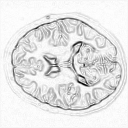
Adaptative Spline Smoothing
Thomas Peter
Microtecnique Deparment
Semester Project
February-June 2001
Abstract
Smoothing is one of the most useful operators in image processing. A classic implementation of the operator is the 'moving average' where the size of the sliding window is limited to the odd integers for a fast implementation. We have developed a novel smoothing algorithm that acts as a weighted mean filter of arbitrary size. The smoothing is done by the convolution of the input image with a rescaled B-spline.
A modification of the method consistes in making it adaptive by choosing a different size of the convolving B-spline for each pixel of the input image. As the algorithm works, it needs a second input image specifying the scale value corresponding to each pixel. We have found that an interesting choice is to use the inverse of the gradient of the input image as scale image for the denoising. After the smoothing, the edges will be preserved which is very desirable as they carry a lot of information. Besides, the noise will be heavily reduced in the low frequency regions where the human visual system is highly perceptible to it.
Examples
 Original Image |
 Inverse Gradient as Input for the Scales |
 Filtered Image |
 Difference (SNR=16.030 dB) |
 Original Image |
Fixed size B-spline |
 Filtered Image |
 Difference (SNR=13.856 dB) |